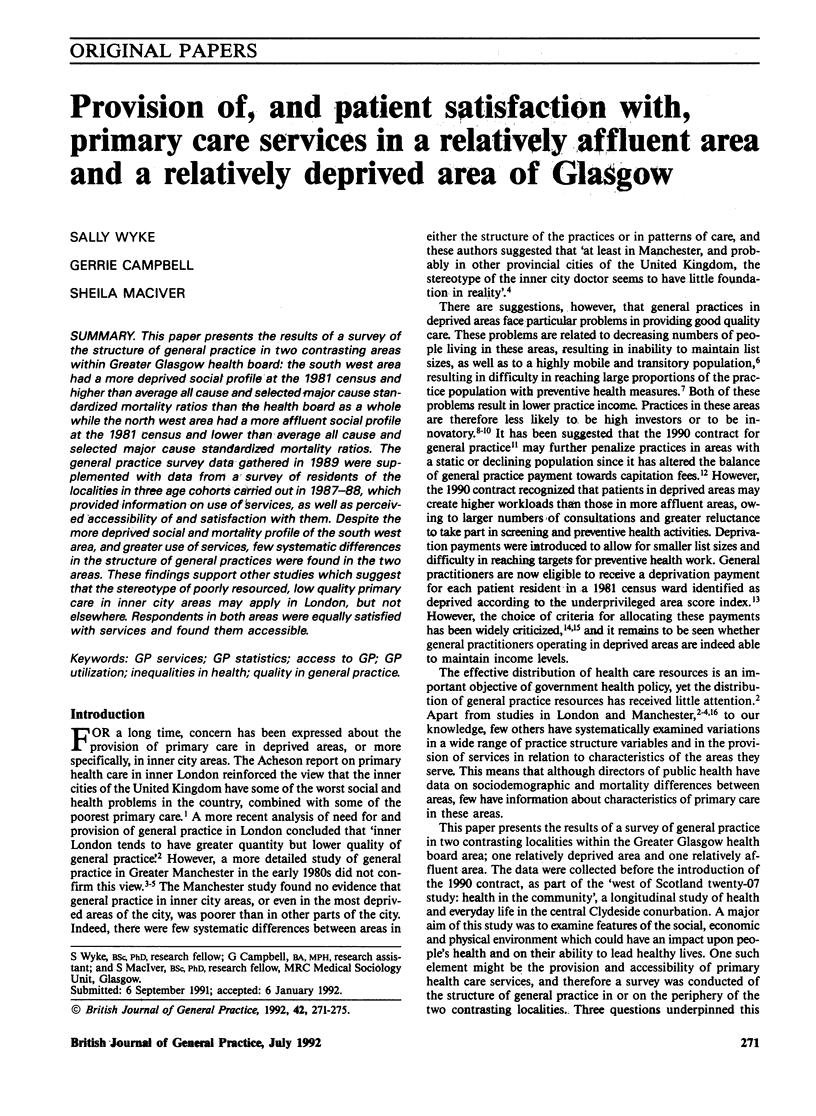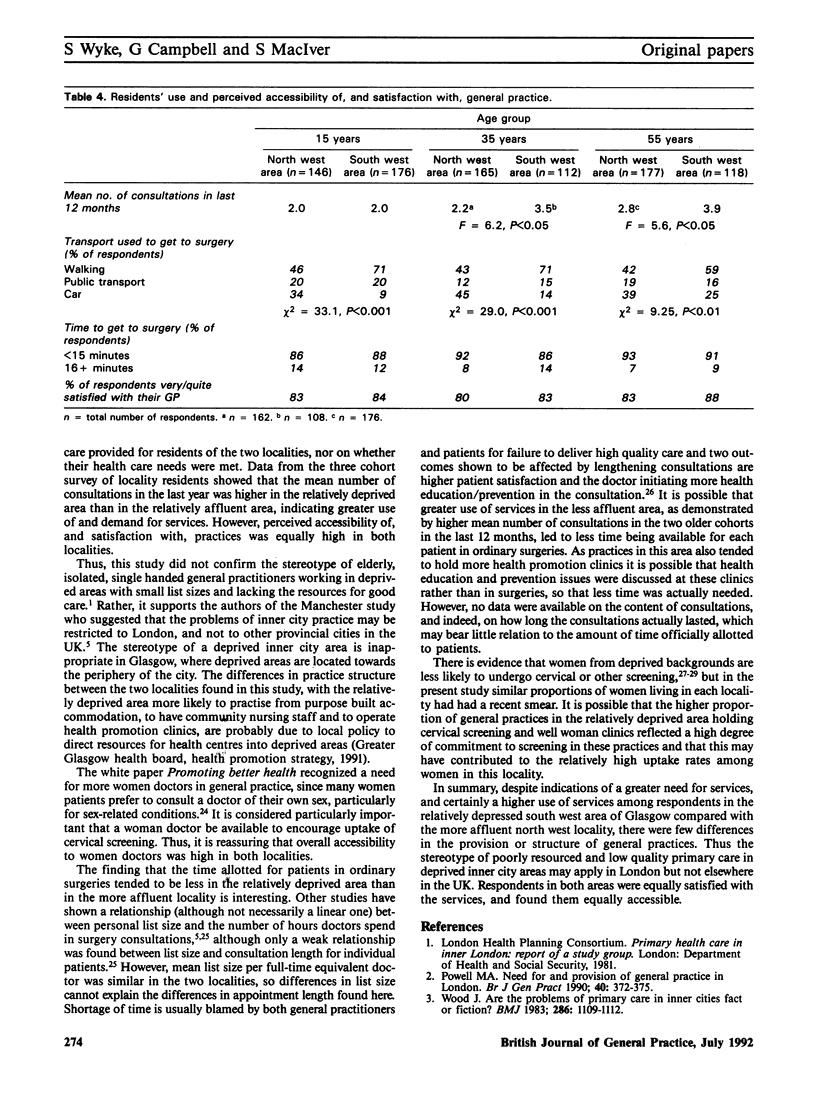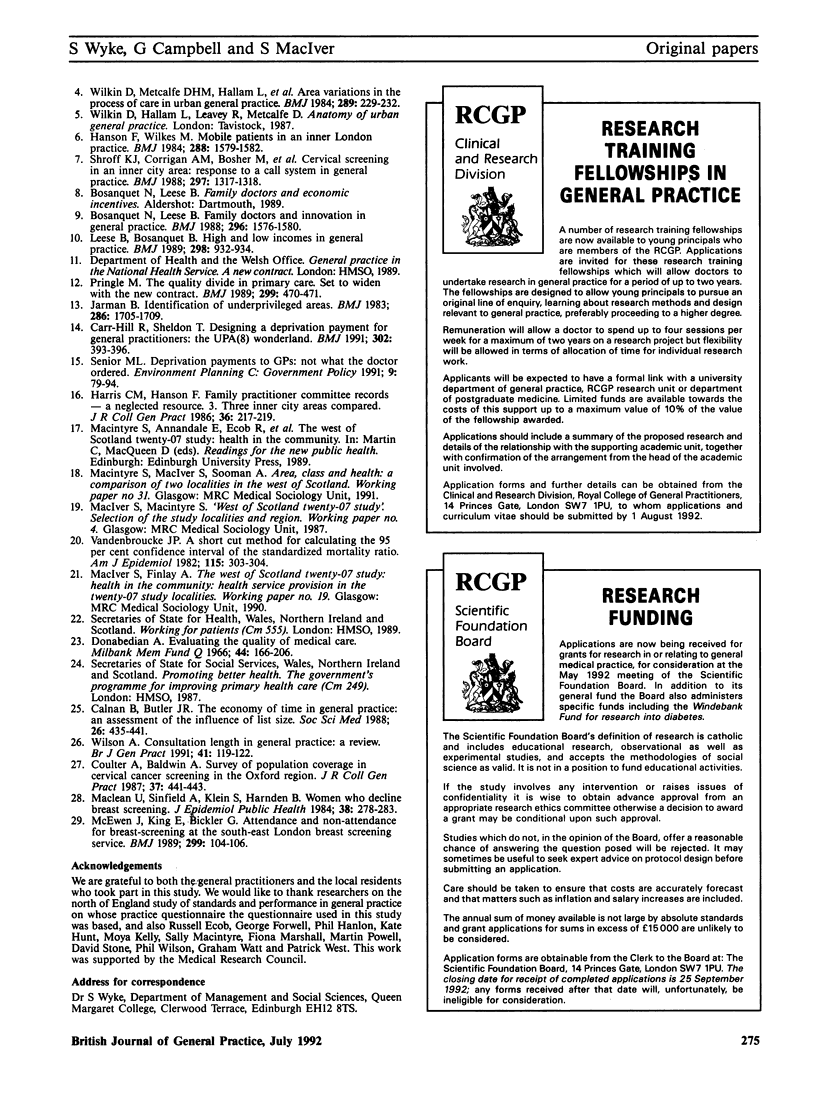Abstract
This paper presents the results of a survey of the structure of general practice in two contrasting areas within Greater Glasgow health board: the south west area had a more deprived social profile at the 1981 census and higher than average all cause and selected major cause standardized mortality ratios than the health board as a whole while the north west area had a more affluent social profile at the 1981 census and lower than average all cause and selected major cause standardized mortality ratios. The general practice survey data gathered in 1989 were supplemented with data from a survey of residents of the localities in three age cohorts carried out in 1987-88, which provided information on use of services, as well as perceived accessibility of and satisfaction with them. Despite the more deprived social and mortality profile of the south west area, and greater use of services, few systematic differences in the structure of general practices were found in the two areas. These findings support other studies which suggest that the stereotype of poorly resourced, low quality primary care in inner city areas may apply in London, but not elsewhere. Respondents in both areas were equally satisfied with services and found them accessible.
Full text
PDF




Selected References
These references are in PubMed. This may not be the complete list of references from this article.
- Bosanquet N., Leese B. Family doctors and innovation in general practice. Br Med J (Clin Res Ed) 1988 Jun 4;296(6636):1576–1580. doi: 10.1136/bmj.296.6636.1576. [DOI] [PMC free article] [PubMed] [Google Scholar]
- Calnan M., Butler J. R. The economy of time in general practice: an assessment of the influence of list size. Soc Sci Med. 1988;26(4):435–441. doi: 10.1016/0277-9536(88)90312-7. [DOI] [PubMed] [Google Scholar]
- Carr-Hill R. A., Sheldon T. Designing a deprivation payment for general practitioners: the UPA(8) wonderland. BMJ. 1991 Feb 16;302(6773):393–396. doi: 10.1136/bmj.302.6773.393. [DOI] [PMC free article] [PubMed] [Google Scholar]
- Coulter A., Baldwin A. Survey of population coverage in cervical cancer screening in the Oxford region. J R Coll Gen Pract. 1987 Oct;37(303):441–443. [PMC free article] [PubMed] [Google Scholar]
- Donabedian A. Evaluating the quality of medical care. Milbank Mem Fund Q. 1966 Jul;44(3 Suppl):166–206. [PubMed] [Google Scholar]
- Hanson F., Wilks M. Mobile patients in an inner London practice. Br Med J (Clin Res Ed) 1984 May 26;288(6430):1579–1582. doi: 10.1136/bmj.288.6430.1579. [DOI] [PMC free article] [PubMed] [Google Scholar]
- Harris C. M., Hanson F. Family practitioner committee records--a neglected resource. 3. Three inner city areas compared. J R Coll Gen Pract. 1986 May;36(286):217–219. [PMC free article] [PubMed] [Google Scholar]
- Jarman B. Identification of underprivileged areas. Br Med J (Clin Res Ed) 1983 May 28;286(6379):1705–1709. doi: 10.1136/bmj.286.6379.1705. [DOI] [PMC free article] [PubMed] [Google Scholar]
- Leese B., Bosanquet N. High and low incomes in general practice. BMJ. 1989 Apr 8;298(6678):932–934. doi: 10.1136/bmj.298.6678.932. [DOI] [PMC free article] [PubMed] [Google Scholar]
- Maclean U., Sinfield D., Klein S., Harnden B. Women who decline breast screening. J Epidemiol Community Health. 1984 Dec;38(4):278–283. doi: 10.1136/jech.38.4.278. [DOI] [PMC free article] [PubMed] [Google Scholar]
- McEwen J., King E., Bickler G. Attendance and non-attendance for breast screening at the south east London breast screening service. BMJ. 1989 Jul 8;299(6691):104–106. doi: 10.1136/bmj.299.6691.104. [DOI] [PMC free article] [PubMed] [Google Scholar]
- Powell M. A. Need for and provision of general practice in London. Br J Gen Pract. 1990 Sep;40(338):372–375. [PMC free article] [PubMed] [Google Scholar]
- Pringle M. The quality divide in primary care. BMJ. 1989 Aug 19;299(6697):470–471. doi: 10.1136/bmj.299.6697.470. [DOI] [PMC free article] [PubMed] [Google Scholar]
- Shroff K. J., Corrigan A. M., Bosher M., Edmonds M. P., Sacks D., Coleman D. V. Cervical screening in an inner city area: response to a call system in general practice. BMJ. 1988 Nov 19;297(6659):1317–1318. doi: 10.1136/bmj.297.6659.1317. [DOI] [PMC free article] [PubMed] [Google Scholar]
- Wilkin D., Metcalfe D. H., Hallam L., Cooke M., Hodgkin P. K. Area variations in the process of care in urban general practice. Br Med J (Clin Res Ed) 1984 Jul 28;289(6439):229–232. doi: 10.1136/bmj.289.6439.229. [DOI] [PMC free article] [PubMed] [Google Scholar]
- Wilson A. Consultation length in general practice: a review. Br J Gen Pract. 1991 Mar;41(344):119–122. [PMC free article] [PubMed] [Google Scholar]
- Wood J. Are the problems of primary care in inner cities fact or fiction? Br Med J (Clin Res Ed) 1983 Apr 2;286(6371):1109–1112. doi: 10.1136/bmj.286.6371.1109. [DOI] [PMC free article] [PubMed] [Google Scholar]


